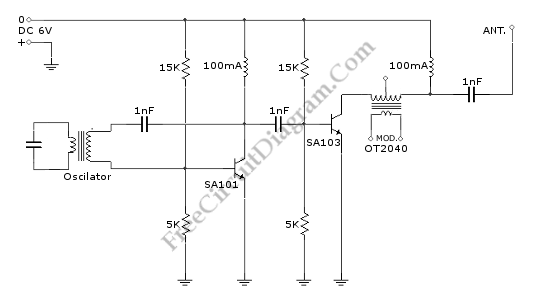
2 Transistors Mini MW Transmitter

This is a Mini MW (Medium Wave) Transmitter circuit. This circuit consists of a combination of transistors SA103 and SA101. These transistors are used as oscillators.
The Mini MW Transmitter circuit is designed to operate in the medium wave band, typically around 530 to 1700 kHz. It employs two transistors, SA103 and SA101, which function as the core oscillating elements of the transmitter. The SA103 is often used for its high-frequency response and stability, while the SA101 serves as a complementary device to enhance the circuit's overall performance.
The circuit usually begins with the SA103 configured as a common emitter oscillator. The oscillator generates a radio frequency (RF) signal, which is then modulated by an audio input. The modulation can be achieved by varying the biasing conditions of the transistor, effectively superimposing the audio signal onto the RF carrier wave.
The output from the SA103 is fed into the SA101 transistor, which is configured as a buffer or amplifier. This transistor amplifies the RF signal, ensuring that it has sufficient power to drive the antenna. The antenna, typically a simple wire or whip antenna, radiates the modulated RF signal into the surrounding environment, allowing it to be received by standard AM radios.
Additional components in the circuit may include resistors, capacitors, and inductors, which are used to set the frequency of oscillation and filter unwanted harmonics. Proper tuning of these components is critical to achieving the desired frequency stability and signal quality.
Overall, the Mini MW Transmitter circuit is a straightforward yet effective design for transmitting audio signals over medium wave frequencies, making it suitable for various applications, including hobbyist projects and educational demonstrations in electronics.This is a Mini MW (Medium Wave) Transmitter circuit. This circuit consist of combination of transistors SA103 and SA101. Those transistors is used as oscillator. 🔗 External reference
The Mini MW Transmitter circuit is designed to operate in the medium wave band, typically around 530 to 1700 kHz. It employs two transistors, SA103 and SA101, which function as the core oscillating elements of the transmitter. The SA103 is often used for its high-frequency response and stability, while the SA101 serves as a complementary device to enhance the circuit's overall performance.
The circuit usually begins with the SA103 configured as a common emitter oscillator. The oscillator generates a radio frequency (RF) signal, which is then modulated by an audio input. The modulation can be achieved by varying the biasing conditions of the transistor, effectively superimposing the audio signal onto the RF carrier wave.
The output from the SA103 is fed into the SA101 transistor, which is configured as a buffer or amplifier. This transistor amplifies the RF signal, ensuring that it has sufficient power to drive the antenna. The antenna, typically a simple wire or whip antenna, radiates the modulated RF signal into the surrounding environment, allowing it to be received by standard AM radios.
Additional components in the circuit may include resistors, capacitors, and inductors, which are used to set the frequency of oscillation and filter unwanted harmonics. Proper tuning of these components is critical to achieving the desired frequency stability and signal quality.
Overall, the Mini MW Transmitter circuit is a straightforward yet effective design for transmitting audio signals over medium wave frequencies, making it suitable for various applications, including hobbyist projects and educational demonstrations in electronics.This is a Mini MW (Medium Wave) Transmitter circuit. This circuit consist of combination of transistors SA103 and SA101. Those transistors is used as oscillator. 🔗 External reference





